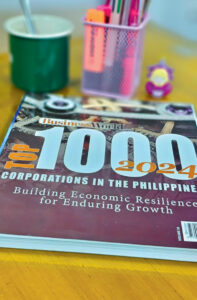By Krystal Anjela H. Gamboa
In an increasingly volatile global economy, the Philippines sits at a crossroads. On one hand, it benefits from a young workforce and growing digital adoption. On the other, it faces persistent risks: geopolitical challenges, technical and trade disruptions, and inflationary pressures. Business leaders and policy makers have one question in mind: How do we move forward with confidence?
Information is thus crucial for companies, organizations, and industries, as they make their next decisions in moving forward. This comes with awareness of the benefits and consequences of every decision made in the past, improving operational efficiency, enabling them to move forward through innovation.
For almost 40 years, BusinessWorld has guided business leaders in looking for where growth can be found. The Top 1000 Corporations in the Philippines magazine and the Quarterly Banking Reports, published by its Research Department, stand out as essential guides for business firms and banks in the country.
Through providing verified data, executives, investors, and other target readers are equipped with information necessary to glean insights and make decisions.
The annual Top 1000 magazine has long been regarded as a definitive scoreboard for Philippine businesses. It offers more than a ranking of the country’s most competitive industries; it paints a detailed picture of how Philippine businesses navigate economic headwinds.
BusinessWorld’s Deputy Research Head Abigail Marie P. Yraola explains, “The magazine gives an overview of how companies in the country thrive amidst trade disruptions and geopolitical tensions, among others. At the same time, it also shows the overall ‘financial health’ of a company.”
In the 2024 edition of Top 1000, the list revealed remarkable resilience throughout 2023. Despite inflation averaging 6% and gross domestic product growth moderating to 5.5%, the Top 1000 companies grew aggregate revenues by 7.2% to P17.8 trillion, while combined net income surged by 13.3% to P2.04 trillion.
Petron Corp. takes the top spot with P440.6 billion in gross revenue; followed by Meralco with P399.36 billion; BDO Unibank, Inc. with P283.75 billion; Shell Pilipinas Corp. with P256.2 billion; Toyota Motor Philippines Corp. with P216.18 billion; TI (Philippines), Inc. with P181.22 billion; Bank of the Philippine Islands with P166.92 billion; and Globe Telecom, Inc. with P157.04 billion.
Sectoral performances also diverged: the services sector continued to power the economy, contributing 55.2% of combined gross revenues; manufacturing retained its role with P5.76 trillion in revenues; while mining and quarrying posted double-digit declines.
Beyond numbers, the magazine also features a competitor table and sectoral ranking that allow businesses to scale their standing against their peers.
“This part of the publication features how companies dominated their respective sectors based on their gross rankings,” Ms. Yraola explained.
Moreover, the magazine offers detailed insights that can sharpen strategy for companies to reassess their competitive edge through distinguishing between parent-only and consolidated financials.
By showing which sectors thrive and which ones lag, the magazine allows firms to identify new opportunities, benchmark performance against competitors, and help industries and organizations recalibrate their paths with confidence.
Beyond this print publication, the Top 1000 Premium platform (top1000.bworldonline.com) harnesses up to 10 years of Top 1000 data to present how a corporation, a conglomerate, or sector has performed in the previous year, alongside previous years. The content ranges from basic company profiles to comprehensive income statements and balance sheets. Presented in an interactive and user-friendly format, the platform enables subscribers to easily navigate and analyze information according to their needs.
While the Top 1000 highlights corporate performance, the Quarterly Banking Reports (QBR) provide a timely window into the country’s financial institutions.
According to the most recent QBR, shares of banks showcased strong growth in the second quarter of 2025 with the financial subindex climbing by 18.4% by the end of June. Out of 13 listed universal and commercial banks, 11 recorded higher share prices compared with the same period last year.
Top gainers were Philippine National Bank, which rose 142.3%; Asia United Bank, 75.6%; China Banking Corp., 69.9%; Philippine Bank of Communications, 37.6%; and BDO Unibank, 19.2%.
During the first quarter, the combined assets of 44 universal and commercial banks grew 9.5% year on year in the first quarter of 2025 to P26.84 trillion, while total loan portfolios expanded by 13.5%, supported by easing inflation and policy rate adjustments.
Overall, the sector’s financial health improved. Combined net income of universal and commercial banks climbed by 3.1% to P184.46 billion, while total loan portfolios expanded by 11% to P14.7 trillion. Nonperforming loans (NPL) dropped to 3.05% from 3.21% last year, reflecting better asset quality. Margins also improved, with net interest margin at 4.13%. Meanwhile, provisions for credit losses jumped to 68%, reaching P71.81 billion, as banks remained cautious of potential risks.
Beyond financial metrics, each QBR focuses on the most pressing or timely developments concerning the financial space. The most recent edition looked into the latest findings on the spending and saving behavior of Filipino consumers, the impact of the Bangko Sentral ng Pilipinas’ (BSP) rules on regulations for online gambling payment services, and how the Capital Markets Efficiency Promotion Act (CMEPA) is changing the game in the Philippine banking landscape.
The first QBR for this year, meanwhile emphasized the sector’s digital shift, noting regulatory milestones such as the BSP’s guidelines for Virtual Asset Service Providers and the pilot Project Agila on wholesale digital currency to improve interbank payments.
Last year, QBRs highlighted the industry’s investments in cybersecurity, such as BSP’s Anti-Financial Account Scamming Act (AFASA) Law. Under the law, the industry has been strengthening defenses against scams and building more resilient digital platforms. The adoption of neobank models in rural banks and the use of artificial intelligence (AI) in reducing risks and consumer redress mechanisms were also discussed.
By presenting such developments in both numbers and context, the QBRs help businesses anticipate changes in credit conditions, liquidity, and consumer sentiment — critical factors in mitigating risks.
Credibility measures and AI
BusinessWorld’s Research Department upholds strict standards of accuracy, going beyond basic fact-checking. Every dataset is drawn from verified filings, cross-checking against multiple sources through established research protocols.
For Top 1000, stock corporations in the Philippines are ranked and measured based on their gross revenues from the most fiscal year. Metrics include the audited financial statements from the Securities and Exchange Commission for private companies, Commission on Audit for government-owned and -controlled corporations, and the Philippine Stock Exchange for publicly-listed companies.
Meanwhile, through tracking the Statements of Condition (SoCs) from universal and commercial banks, the QBRs track key indicators such as capital adequacy, loan growth, liquidity, and profitability. Discrepancies are clarified together with the banks themselves.
While overreliance on AI raise concerns about information consumption, its true value is shown in its efficiency.
“The use of generative AI can only be of help when we want to maximize the time and maybe [for tasks] such as quick analysis. But it should not be used when we make or generate tables for the Top 1000 and the banking tables,” Ms. Yraola pointed out.
At their very core, Top 1000 and QBRs are not just mere compilations of numbers; they are decision-making tools. For corporate leaders, they point to opportunities for expansion. For financial institutions, they highlight risks and innovations shaping the industry. For policy makers, they provide a factual basis for crafting responsive strategies.
In a time of uncertainty, these publications reaffirm a simple but powerful truth: reliable data leads to more informed decisions; and informed decisions, in turn, build the foundations of sustainable growth for the Philippine economy.





